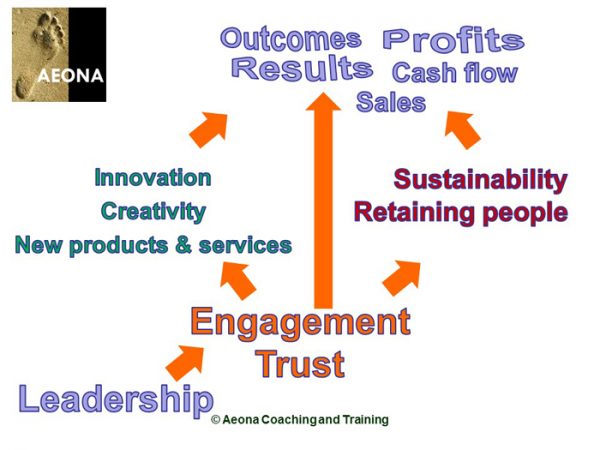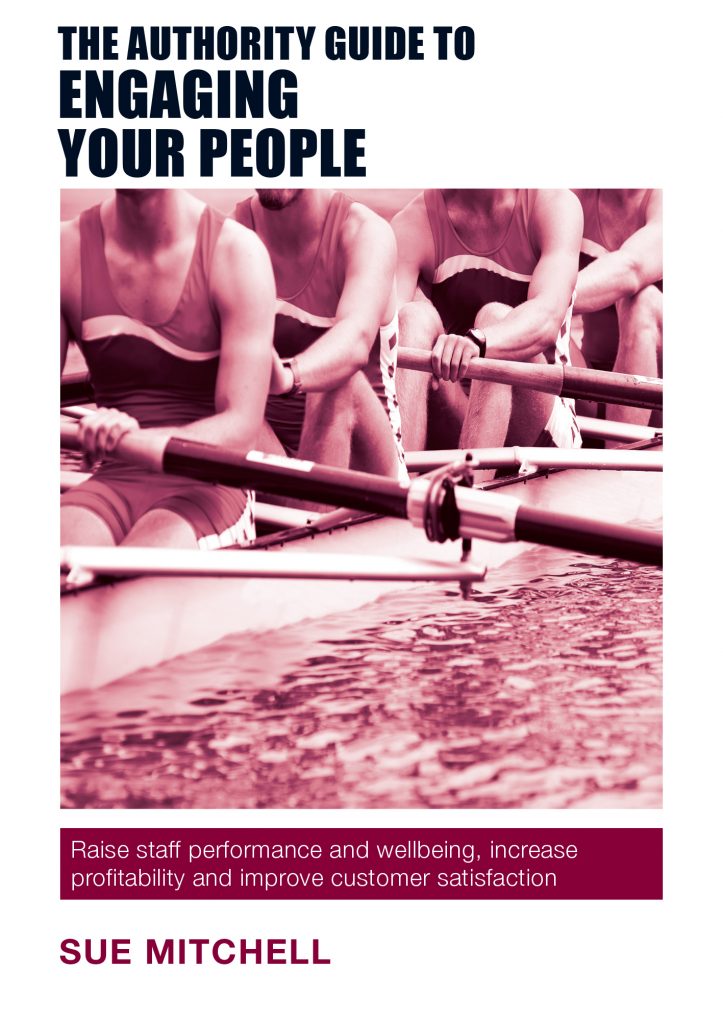Leadership, Engagement & Wellbeing
Sue’s unique approach in her leadership development programme encompasses mental wellbeing and a positive growth mindset to underpin raising engagement, which leads to improved team relationships and higher performance on a wide range of metrics such as productivity, profitability and staff retention. On a personal level, it also makes your workplace a nicer and more enjoyable place to be, which is a serious consideration when you realise most of us spend over 50% of our waking hours at work.
Great Leadership
Great leadership is essential for success in all organisations, because all organisations depend on people to get the work done. Leadership emerges from the relationships you develop with your people, which means it is not enough to rely on your job title, you need to ‘earn the right’ to lead people. This becomes even more important when you need to influence others and get work done through peers, staff in other departments or multiple stakeholders from different organisations.
Your organisation can’t survive without people, whatever the nature of your work, the kind of organisation or size of business! Sole trader to global corporate, local charity to international NGO, engineering or technology to arts or therapies – ultimately your business needs people in order to thrive. (Even if you are the only person in your business, you need to engage yourself, your customers, your suppliers, your extended team – accountant, PR, and so on.) The research indicates leadership can add or detract 15% from company performance and that people frequently leave a job because of their manager. Losing staff brings costs of reduced performance before they leave and before they are replaced, costs from loss of expertise and know-how as well as costs of recruitment and developing the new person to get them up to speed. There may also be costs from the disaffected person spreading dissent and negativity which could reduce performance widely through your organisation.

Engagement Matters
When you inspire your people to be engaged with their work, they are personally motivated and make your business great. They make a psychological commitment and an emotional commitment to their work, the project, your team and your organisation. Conversely, when you actively disengage your people they can break your business – are you aware how your actions and behaviour influence how the people around you feel? Unfortunately many leaders focus on what needs to be done and are unaware of how important it is to think about the way you go about doing this to ensure that you make people feel positive and fully engaged and they pull together in the same direction.
Employee engagement matters. People can add or detract value to organisations and repeated research consistently shows that business success is driven by engaged employees. Yet despite this, recent surveys show that engagement levels typically remain low in organisations of all types and across different countries. The 2013 Gallup “State of the Global Workplace” reports that worldwide only 13% of people are actively engaged in their work. Most employees are ‘not engaged’ (63%) meaning they lack motivation and are less likely to invest discretionary effort in organisational goals or outcomes. Even worse, 24% are ‘actively disengaged’ meaning they are unhappy and unproductive at work and liable to spread negativity to colleagues and other people in the organisation. In United Kingdom only 17% of employees are engaged, 57% are not engaged while 26% are actively disengaged and spreading unproductiveness, negativity and dissent within the organisation.
Resilience and Wellbeing
Engagement helps organisations of all kinds to be more resilient and succeed through periods of change, uncertainty and turbulence. The UK is about to head into very uncertain times with the referendum result to leave the EU…. Now is the time to engage people in your business so you all pull together in the same direction. Resilience starts with building mental strength as individuals, which collectively builds a resilient culture throughout the organisation, especially when organisational strategies and processes are reviewed to ensure they support rather than frustrate people. More than ‘bouncing back from adversity’ you have a positive sense you WILL get there no matter what obstacles arise, you embrace challenges and identify opportunities, focus on what you can do best, make it possible for your people to bring all their capabilities and skills into work, feel proud to work here and you make your organisation thrive. Resilience helps your organisation soar above all the obstacles.

Why should leaders think about wellbeing?
There are both business and people benefits in the workplace.
When you create better psychological wellbeing, particularly through creating an environment and culture where everyone feels included and can flourish; and through supporting people to develop their personal resources and mindset, you create higher engagement, productivity and performance.
When people are happier and healthier, they work better together, are more focused at work and have less days off work, and the research shows they also live longer. Everyone delivers better results, more sustainably for themselves, for their team and for their organisation.
Mental wellbeing is influenced both by external conditions and by personal resources, both of which you as a leader can influence in your organisation. What are you doing to ensure external conditions support people in your organisation to feel positive rather than frustrated or stressed? These can include the organisational structure, systems, processes, resources provided, material conditions and social context, amongst others. What are you doing to support everyone to have all the personal resources they need to thrive and excel in your organisation? These include not only the skills and capabilities that are normally considered in the workplace, but also vital support to maintain health, work-life balance, resilience, optimism, self-esteem, confidence, emotional intelligence and other aspects of your high performance mindset.
Evidence from neuroscience shows that feeling positive, and especially safe, unstressed and unthreatened, opens up access to the higher reasoning cognitive part of brain which leads to more creative thinking, inspiration, new ideas, solution finding, problem solving, focus and improved social interaction, all of which support higher performance at work. When you feel negative or stressed, your brain literally shuts down access to the cognitive areas of the brain, resulting in poor focus, feelings of overwhelm, interpersonal conflicts, inability to listen to different perspectives and poor decision making, all of which have a negative impact on performance and productivity.
Therefore there are GREAT business reasons to focus on creating a positive environment in your workplace and supporting your people to develop their personal resources to feel more resilient, confident and grow a high performing positive mindset.
This is why Sue’s leadership programme, which is certified by the Institute of Leadership and Management as an ILM Development Programme, has a focus on Leadership, Engagement and Wellbeing. Please do get in touch if you would like more details. Her range of talks and masterclasses draw on content from the programme and you can have stand-alone sessions or a minimum of four masterclasses to register for the ILM qualification.


